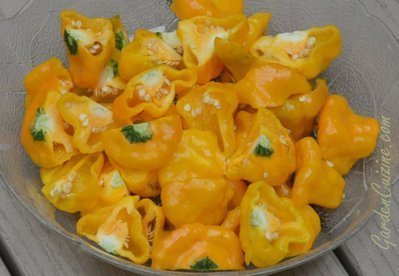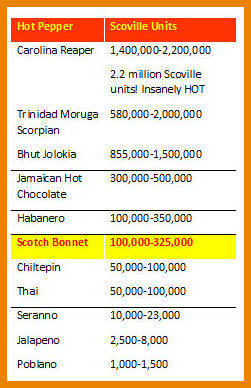





You don't have to live in Jamaica to grow Scotch Bonnet hot peppers. They grow easily in US backyard and community gardens too. Scotch Bonnets make a delicious and nutritious addition to spice up healthy meals.
When asked about Scotch Bonnets, Pepper Joe - an experienced hot pepper grower of www.pepperjoe.com - says, "They are common in the Caribbean, found most often in red, but also in yellow and orange."
Types of Scotch Bonnet Hot Peppers
As with most plants, there are more than one type of Scotch Bonnets. When we bought our plants this past spring at a local garden center, the tag just said Scotch Bonnet, with no indication of the cultivar. For many hot pepper fans, just knowing that it is Scotch Bonnet seems to be enough. Most seed suppliers don't state the particular cultivar.
Personally, a cultivar I'd like to find would be Scotch Bonnet Chocolate, since I'm a fan of plants with burgundy, or brownish color tones. Other cultivars listed in Dave's Gardens PlantFiles include: Orange Scotch Bonnet and Scotch Bonnet Tobago Sweet.
Nutritious H ot Stuff
ot Stuff
Scotch Bonnets grow naturally in tropical heat and are used in cuisines in Grenada, West Africa, Trinidad, Barbados, Jamaica, Haiti and the Cayman islands.
Peppers are packed with potassium and vitamins A, C and dietary fiber. "The Scotch Bonnet is one of our customers' favorite Peppers," says pepper seed seller, Pepper Joe. "The versatile Scotch Bonnet is about as hot as its cousin, the Habanero pepper...an average of about 200,000 Scoville Heat Units," which are high as far as hot peppers go. In terms of Scoville units they are said to be in the range of 100,000 to 325,000.
People are more familiar with Jalapenos and agree that they are spicy hot. But they pale in comparison to Scotch Bonnets. See chart (shown) for a comparison of their heat, along with others, to put their Scoville units in perspective.
Hot peppers of various varieties that are dried and either ground or left whole can last for years in airtight storage in your pantry, while still retaining their heat and flavor.
Staple in Caribbean Cooking
Scotch Bonnets add great flavor to Jamaican Jerk sauce, hot sauce, and Escoveitch sauce. Pepper Joe describes these delicious peppers as having, "a twinge of sweetness to its heat, and a slightly smoky undertone." Scotch Bonnets are hot, but not too hot that they can't be enjoyed in family recipes. I recently made Cream of Heirloom Tomato Soup and added just half a fresh Scotch Bonnet to 10 cups of chopped heirloom tomatoes, which added just enough spice for all to enjoy.
Growing Hot Peppers
When asked about growing Scotch Bonnets, Pepper Joe said, "Our preferred fertilizer for the Scotch Bonnet is Fish Emulsion applied every two weeks. Adding an Epsom salt foliar spray in between fertilizing will give you an abundant yield." He recommends 2 tablespoons of Epsom salt in a 16-ounce spray bottle filled with water.
Pepper seeds (hot or sweet peppers) can be started indoors about a week before you start tomato seeds, which for those in areas with winter, is usually about one week prior to St. Patty's Day, or about 8 to 10-weeks before your last frost.
Once started indoors under grow lights or over-wintered, your pepper plants can then be moved to a sunny spot in the garden. Peppers grow well with plenty of sun and warm soil.
Pepper Growing Tip: Pepper Joe recommends growing Scotch Bonnet plants in a 5-gallon container and over-wintering them for a big head start the following Spring. We have done this with Chiltepin pepper plants and it really does lead to abundant yields. Also, some peppers take a long time to ripen and can finish ripening indoors. (I wish we had done this with our Habanero peppers that are now planted in raised beds and loaded with peppers that are not going to have time to ripen with the onset of Fall and cool temperatures.)
Happy and Healthy Gardening!
Special Thanks to Pepper Joe! For More tips on growing a banner crop of hot peppers you can find more information on Pepper Joe's website: http://www.pepperjoe.com
Thumbnail, Hot Pepper chart, and pepper plant photos Copyright ©Wind. All rights reserved.
Related Links
Scott Roberts: What is the Scoville Scale
World's Hottest Pepper
Pepper Joe's video on Over-Wintering your Peppers
Delaware State University Cooperative Extension: Scotch Bonnets
Copyright © www.100flowers.win Botanic Garden All Rights Reserved